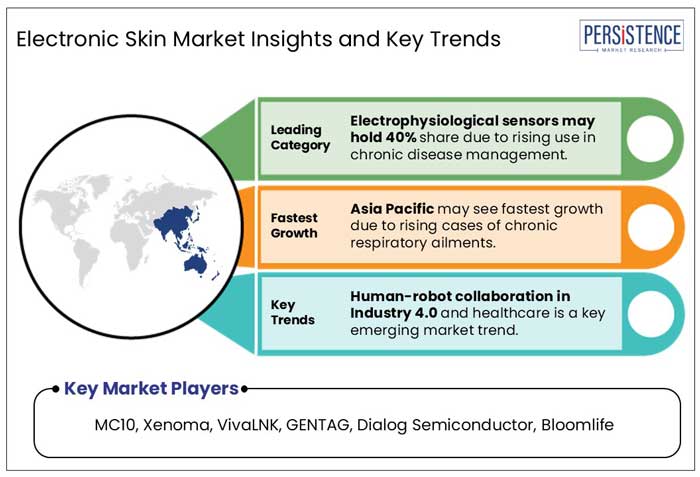Industry: Healthcare
Published Date: March-2025
Format: PPT*, PDF, EXCEL
Delivery Timelines: Contact Sales
Number of Pages: 250
Report ID: PMRREP35170
The global electronic skin market size is anticipated to rise from US$ 11.61 Bn in 2025 to US$ 31.06 Bn by 2032. It is projected to witness a CAGR of 15.1% from 2025 to 2032.
Electronic skin is an evolving technology designed to mimic the properties of human skin. It transforms patient care, offering real-time health monitoring and personalized treatment plans.
The journey of e-skin technology is nothing short of remarkable. Initially developed for advanced robotics, its potential in healthcare soon became evident.
E-skin comprises flexible, stretchable sensors capable of detecting physiological parameters such as heart rate, temperature, and blood pressure. The seamless integration with the human body allows continuous monitoring without the discomfort associated with traditional devices.
The market for electronic skin is poised for significant growth, driven by advancements in sensor technology, AI integration, and increasing demand for non-invasive health monitoring solutions.
As research and development continue to flourish, e-skin is set to revolutionize healthcare and sectors like cosmetics and wearable technology by offering innovative solutions that enhance human well-being.

Key Highlights of the Electronic Skin Market
|
Global Market Attributes |
Key Insights |
|
Electronic Skin Market Size (2025E) |
US$ 11.61 Bn |
|
Market Value Forecast (2032F) |
US$ 31.06 Bn |
|
Projected Growth (CAGR 2025 to 2032) |
15.1% |
|
Historical Market Growth (CAGR 2019 to 2024) |
12.3% |
Increased Investments in Biomedical Research Augmented Market Growth
During the historical period from 2019 to 2024, the market was in its early growth stage, primarily driven by rising demand for wearable health monitoring devices, advancements in nanotechnology, and increasing investments in biomedical research.
Major players in the industry focused on flexible, self-healing materials. Industries such as healthcare, robotics, and prosthetics began integrating e-skin for real-time health monitoring and tactile sensing.
Next-Gen Prosthetics to Propel Market Revenue Over the Forecast Period
Over the forecast period, the market for electronic skin is expected to witness explosive growth, fueled by AI-powered diagnostics, remote patient monitoring, and next-gen prosthetics.
The integration of IoT and 5G connectivity will enable seamless real-time health tracking, making e-skin an essential component of smart healthcare.
Innovations in stretchable batteries and bio-compatible sensors will make electronic skin even more efficient, revolutionizing medical wearables, sports performance tracking, and even virtual reality (VR) applications.
Growing Applications in Human-Machine Interfaces and Prosthetics Act as a Crucial Growth Driver
Integrating electronic skin in robotics, prosthetics, and human-machine interfaces (HMI) is revolutionizing multiple industries. E-skin-equipped prosthetics can provide amputees with real-time sensory feedback, allowing them to "feel" touch, temperature, and pressure like natural limbs.
The e-skin innovation drastically improves the quality of life for individuals with limb loss, making artificial limbs more intuitive and responsive. In robotics, tactile sensing e-skin enhances collaborative robots (cobots) used in manufacturing, healthcare, and logistics.
Such robots can detect external stimuli, adjust grip strength, and perform delicate tasks without damaging objects. These advancements make human-robot interaction safer and more efficient, driving demand for high-performance e-skin sensors.
Electronic skin technology is further paving the way for next-gen virtual reality (VR) and augmented reality (AR) experiences.
By integrating touch-sensitive e-skin with haptic feedback systems, users can experience realistic textures and sensations in digital environments. As AI, machine learning, and brain-computer interfaces (BCIs) continue to evolve, e-skin will play a pivotal role in bridging the gap between humans and machines.
Durability and Power Supply Limitations are Major Barriers to the Market's Growth
Despite its impressive capabilities, electronic skin faces durability challenges, limiting its long-term usability. Since e-skin is designed to be thin, flexible, and stretchable, it is prone to wear and tear, reducing its lifespan compared to traditional rigid electronics.
Everyday use in prosthetics, healthcare monitoring, and robotics exposes e-skin to sweat, dust, moisture, and physical stress, making material degradation a significant concern. Another major issue is power supply and energy efficiency. Many e-skin designs rely on tiny, flexible batteries that require frequent charging, reducing their practicality.
While self-powered e-skin solutions using body heat or motion-based energy harvesting are being explored, they are not yet widely available. The development of long-lasting, self-sustaining energy sources is crucial for enhancing e-skin's reliability and making it a viable alternative to traditional medical and robotic sensors.
Enhancing Human-Robot Collaboration in Industry 4.0 & Healthcare Creates Major Opportunities for E-Skin Manufacturers
The rise of collaborative robots (cobots) in industries such as manufacturing, logistics, and healthcare presents another massive opportunity for electronic skin technology. Unlike traditional rigid robots, cobots require advanced tactile sensing to interact safely with humans and perform delicate, high-precision tasks.
E-skin-equipped robots can "feel" pressure, temperature, and texture, allowing them to detect obstacles, adjust grip strength, and perform complex movements with a human-like touch.
In elderly care and rehabilitation, humanoid robots with e-skin can provide gentle physical support, assist with mobility, and monitor patients' vitals in real time. As healthcare sectors push for safer and more intuitive human-machine collaboration, e-skin will be a game-changer in digital health, robotics, and AI-driven healthcare.
Electroactive Polymers Own 30% Market Share Owing to its Prominence in Advanced Wearable Technology
Electroactive Polymers (EAPs) are materials that exhibit a change in size or shape when stimulated by an electric field, making them ideal for applications requiring flexibility and responsiveness. Its unique properties enable the creation of an e-skin that can mimic the tactile sensations of human skin, providing real-time feedback on pressure, strain, and touch.
EAPs are integral in developing wearable health monitors that conform seamlessly to the human body, allowing for continuous tracking of vital signs such as heart rate, blood pressure, and muscle activity. The real-time data collection enhances patient care and facilitates early detection of medical conditions.
As research and development continue to enhance the properties and applications of EAPs, their contribution to the growth and diversification of the market is expected to expand further.
Electrophysiological Sensors Dominate with 40% of the Market Share Due to Increasing Use in Chronic Disease Management
Electrophysiological sensors are designed to detect and measure electrical activity generated by the body's physiological processes. These sensors are integral to e-skin applications, enabling the monitoring of vital signs such as heart rate, muscle contractions, and neural activities.
The ability of these sensors to provide real-time data is crucial for various healthcare applications, including chronic disease management and rehabilitation therapies.
With the global rise in chronic conditions like cardiovascular diseases and diabetes, there's an increasing demand for continuous health monitoring.
Electrophysiological sensors embedded in e-skin offer non-invasive, real-time tracking of vital parameters, aiding in early detection and management. The prominence of electrophysiological sensors in the e-skin market underscores their vital role in advancing healthcare monitoring, enhancing patient outcomes, and supporting the shift toward personalized medicine.

The rising prevalence of chronic diseases, including cardiovascular and neurological problems and dermatological and orthopedic conditions, is a significant driver of market expansion in North America.
Factors contributing to the region's leadership include a robust infrastructure supporting e-skin technology, extensive research and development (R&D) initiatives, and substantial government funding.
For instance, researchers from Texas A&M University have developed 3D e-skin leveraging nano-engineered hydrogels, showcasing the region's commitment to innovation in healthcare and human-machine synergy.
The market for electronic skin in the US constituted a substantial portion of the market share in the North American region. The country's preeminence can be ascribed to sophisticated technical advancements, rising demand for wearable health monitoring devices, and an escalating emphasis on patient-centered healthcare solutions.
The United States hosts prominent players and research organizations that propel advancements in electronic skin technology. Legislative endorsement and investment in healthcare technology facilitate market expansion.
The expansion of electronic skin applications across diverse areas, such as healthcare, consumer electronics, and robotics, positions the US market for sustained growth and advancement.
Asia Pacific is predicted to experience the fastest growth in the e-skin market. Key reasons for the region's growth are the increased healthcare investments, a growing senior demographic, and a rising incidence of chronic respiratory ailments.
Countries such as China, Japan, and South Korea, renowned for their electronics manufacturing capabilities, are at the forefront of this expansion. For instance, researchers from the University of Tokyo have developed a full-body e-skin embedded with electronic circuits capable of measuring muscle movement, posture, and heartbeat, exemplifying the region's advancements in smart textiles.
The region's large pool of engineers and developers specializing in materials science and soft robotics fosters a conducive environment for e-skin innovation. Collaborative research efforts and supportive government policies further stimulate market growth in the region.
Europe is experiencing substantial expansion, propelled by growing consumer awareness regarding health and wellbeing. The increased awareness stimulates demand for e-skin patches that provide continuous monitoring and early diagnosis of health concerns.
The increasing incidence of chronic disorders, including diabetes and cardiovascular diseases, needs continuous health monitoring solutions offered by wearable e-skin patches. The increasing incidence of chronic diseases and enhanced availability of advanced skin patches are expected to stimulate market expansion in the region.
The electronic skin (e-skin) market is experiencing rapid growth, driven by technological advancements and diverse applications across healthcare, robotics, and consumer electronics sectors.
Key players in this market focus on innovation and strategic collaborations to enhance their market presence. Companies are keen on developing solutions that assist users in daily physical functions, showcasing a commitment to integrating e-skin technology into practical applications.
Despite the promising growth trajectory, challenges such as high development and implementation costs persist, potentially hindering widespread adoption. The continuous evolution of e-skin technology and expanding applications suggest a vibrant and competitive landscape ahead.
|
Report Attributes |
Details |
|
Historical Data/Actuals |
2019 - 2024 |
|
Forecast Period |
2025 - 2032 |
|
Market Analysis Units |
Value: US$ Bn/Mn, Volume: As applicable |
|
Geographical Coverage |
|
|
Segmental Coverage |
|
|
Competitive Analysis |
|
|
Report Highlights |
|
|
Customization and Pricing |
Available upon request |
By Component
By Application
By Sensors
By Region
To know more about delivery timeline for this report Contact Sales

The market is set to reach US$ 11.61 Bn in 2025.
MC10, Xenoma, VivaLNK, are a few leading players.
The industry is estimated to rise at a CAGR of 15.1% through 2032.
It is a technology that aims to create a flexible, lightweight and stretchy material that can sense and react to environmental changes.
The market is anticipated to reach a valuation of US$ 31.06 billion by 2032.